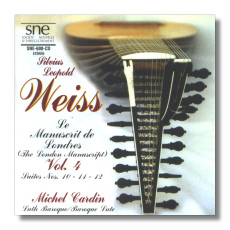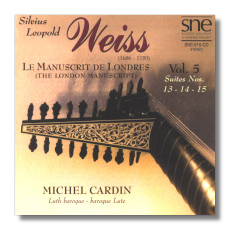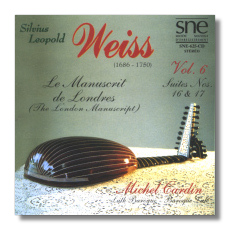
The Internet's Premier Classical Music Source
Related Links
- Weiss Reviews
- Latest Reviews
- More Reviews
-
By Composer
-
Collections
DVD & Blu-ray
Books
Concert Reviews
Articles/Interviews
Software
Audio
Search Amazon
Recommended Links
Site News
 CD Review
CD Review
Silvius Leopold Weiss

The London Manuscripts
Volume 4
- Suite #10 in B Flat Major
- Suite #11 in A Major
- Suite #12 in C Major
Michel Cardin, lute
Société Nouvelle d'Enregistrement SNE-608-CD


Volume 5
- Suite #13 in D Major
- Suite #14 in F Major
- Suite #15 in F minor
Michel Cardin, lute
Société Nouvelle d'Enregistrement SNE-615-CD


Volume 6
- Suite #16 in G Major
- Suite #17 in B Flat Major
Michel Cardin, lute
Société Nouvelle d'Enregistrement SNE-625-CD
(All CDs also available from Michel Cardin.)
There are now no fewer than three cycles (complete and projected) of Weiss' (1686-1750) lute music in the catalog (see the Weiss Discography for further details):
- Robert Barto's on Naxos, of which eight discs are now available,
- Yasunori Imamura on Claves 2613, of which we so far have one disc, which was favorably reviewed here recently,
- Michel Cardin on SNE, of which we have all twelve available already. His claims to be the first time the complete London Manuscript has been systematically recorded. My review found the first three CDs in the series to be of a very high standard indeed.
Unsurprisingly, since they're in the same series – recorded in the Église de Saint-Augustin de Mirabel (Quebec), actually over ten years ago – the next three CDs in the series are of the same high standard. The "London Manuscript", on which these performances have been based, was acquired by the British Museum in 1877 and ordered, researched, cataloged by one D. A. Smith, whose numbering system is referred to in the very comprehensive and informative booklets accompanying each CD. From Smith's and subsequent researchers' findings, it's clear that Weiss carried out extensive revision on most of his works. On listening carefully to each suite, it's easy to hear such care for detail; but also hear "past" these technical revisions to the beauty and inventiveness of the music. It's Cardin's gift that he's equally at home with superb technique and interpretative insight. The music truly lives under his fingers.
Significantly, the ornamentation (in particular) used by Cardin reflects similarities and parallels in sonorities between the lute and the harpsichord. Indeed early Baroque composers were inspired by the features of the lute and their compositions were at times influenced by such styles peculiar to the lute as style brisé and broken chords. Later in the period the situation was reversed, works for the lute used, for instance, runs and arpeggios. If it weren't clear from the playing (which it is) just how immersed Cardin is in the minutiae of the lute, its strings, string manufacture, whether or not to use nails (Weiss preferred not to), his meticulous exposition throughout the documentation – really a series of pithy, focused essays; each CD's booklet also has a useful background/introduction – makes it plain.
Now, whereas the first three CDs in the series used a theorbo-lute, for reasons of the transpositions necessary in performing the tenth suite, it became necessary for Cardin to use a standard lute – in fact the Canadian Museum of Civilization made a lute by Richard Berg from 1992 in Ottawa available. It's a copy of a late Renaissance instrument by Hans Burkholzer of 1596, that was converted in 1705 to a Baroque lute by another well-known luthier, Thomas Edlinger. The original is in the Vienna Kunsthistoriches Museum. The biggest difference for Cardin between this and theorbo-lute is that the latter has a brighter base. The Edlinger is warmer but more somber. Certain of the movements – parts of Suite 14, for example – also suggest that the standard lute was the instrument for which Weiss composed; this was due in particular to fingering requirements.
It's useful to understand how Cardin approaches the performance of Weiss since this is very much a one-person project. His starting point has been the manuscripts in all their roughness and with all their uncertainty. The musicology that has evidently gone into combing, sifting and re-presenting sources is phenomenal. Indeed in the review of the first three discs in this series mention was made of the various extant manuscripts of these suites… those associated with London, Dresden and Warsaw. Lacunae in one or the other are filled by details in one of the 40 or so other sources scattered in various libraries in the world. Greater accuracy has been made possible by comparisons and cross-references between them. But the strength of the series rests as much on how Cardin's musicological inquiry and discovery have informed his playing – together with a vast experience of late Baroque practice – as almost anything else. This means that, in researching, preparing and then recording Weiss' oeuvre like this, Cardin has furnished us with as near definitive an encapsulation of such a world as possible.
At the same time, there is as much interpretative color and reflection as in the other Weiss series available. Cardin's is not an "illustrative" recording to support any irrelevant and specialist theory of his. In a nutshell, Cardin has tried, it seems, to get inside the soul of Weiss and produce a set of recordings as close as we can imagine to performances as Weiss might have wanted them. Note too that Cardin believes that each suite was made as "a unique statement", that is – homogeneous in tone, impact and musical purpose. This is a somewhat advanced idea for the first half of the eighteenth century; Cardin's style of playing supports the idea, though. We should not forget the exhortation of Princess Sophie Wilhelmine, Weiss' student, to think of him as someone who "never had an equal and that his successors must remain content to imitate him."
Suite 10 is a suite (Weiss knew them as suonate, "sonatas") of real dignity and peace. Cardin likens its feel and tone to Schubert. In common with the other suites on this CD it has no prelude and a "paysanne" (a rough and ready upbeat folk-inspired movement); the opening allemande in each case is the longest movement. Few of these suites last more than just under half an hour and achieves a significant amount in that time. If you happen to start your listening at this point, you'll be struck by a graceful stylishness throughout. The eleventh suite is equally dignified while at the same time adding a note of melancholy and regret in its use of A Major. The "air en écho" is performed as a courante, more because of its position in the suite's sequence of movements than because there are unambiguous markings in any of the manuscripts. Simple sublimity is again the hallmark of this piece. The twelfth suite is different: much less "sure on its feet" and full of flourishes (see Cardin's short explanation in the background notes for this suite and specifically the way he has used purely Weissian techniques of ornamentation – although they may sound out of place to some listeners), it bespeaks the flamboyance of the French and particularly Italian courts, with the music of which Weiss was familiar.
Suite 13 is the first of five to have a supposedly unambiguous dating: 1719. It's a virtuosic piece with plenty of forward momentum; the writing in parallel octaves and indeed aspects of its structure suggest a more Classical than Baroque feel. In 1719! The final movement, a passacaille, will be familiar to guitarists as an exemplum or test piece. Listening to it in context is more rewarding. Number 14 is Bach-like with a kind of permissiveness in the sheer sound of the lute. Exuberant, triumphal almost, this is a suite in which Weiss seems – unassumingly, of course – to want to sit back and have us marvel at his breadth of strategies for matching technique to musical purpose. Suite 15 is, in contrast, somber and melancholy. The key (F minor) is largely responsible for the atmosphere of this suite. Listen to the sarabande… almost despair-inducing. This movement is also a good example of the way Cardin refuses to be rushed and may employ a variety of tempi in a variety of thematic and melodic material. As is evident in the fidgety bourrée and minuet, the depression is further deepened by an unself-conscious agitation.
Suite 16 is different from the preceding 15 in that it begins with a united prelude-toccata-fugue overture. Like number 17, it's also longer – lasting over half an hour. Number 16 is a dignified, not to say, lofty work and evokes feelings of dignity and decorum. Solemnity somehow pervades through several lighter passages (e.g. some quite rapid and spectacular arpeggios and a down-to-earth bouré) making this a very attractive suite, which Cardin tackles determined to respect this depth and drama. Number 17 is also different in that it is the only piece in the entire oeuvre to have a "title", Divertimento à solo. Despite which, there is a certain grandeur here too. It may be no co-incidence that it is from this point (number 17) in the sequence that Weiss displays greater leeway in how he constructs and arranges his movements… their names and sequences become more unconventional. Despite the appearance in the movement listing of multiple bourés, menuetts and gavottes, it's clear that these are to be played as wholes ensuring a balance that would otherwise be thrown out by an apparent ten-movement structure. The symmetry and integrity of Weiss' vision once more.
This batch of three CDs (more next time), then, has everything to recommend it. The recording is rich – maybe just a tiny bit over reverberant. the playing of the highest standard and the evidence for a carefully and thoughtfully-produced complete "package" (from the imaginative CD cover art to the afore-mentioned more than ample liner notes and details) clear and convincing. Have no hesitation in making the effort to hear, perhaps, a sample of this convincing, subtle and highly pleasing repertoire. Then buy the lot!
Copyright © 2007, Mark Sealey


















